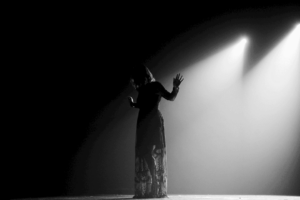The word “avant-garde” comes from the French for “advance guard,” as in the first person to see or experience anything new. When used about a piece of work, the adjective describes something that pushes or breaks conventions, invents new methods or aesthetics, or rebels against accepted wisdom with wild or unusual concepts and presentation methods. When avant-garde works are first published, they are sometimes belittled or condemned for being so controversial and disrupting the established status quo. Despite opposition, avant-garde works are frequently seen as important to forge ahead and make long-term progress in artistic expression and creative freedom. Discover the world of avant-garde art and innovation.

How Did the Term Avant-Garde Emerge?
The word avant-garde is originally a French word that means vanguard or advance guard (a part of an army that advances) in English. It initially appeared in art in France in the early half of the nineteenth century. It is sometimes attributed to Henri de Saint-Simon, a well-known thinker and one of socialism’s early proponents. He regarded artists as the leaders of a new society, along with scientists and business people, because he believed in the social power of the arts. Gustave Courbet’s realistic paintings from the 1850s, heavily influenced by early socialist ideals, can be considered the beginning of avant-garde art. The succeeding movements of modern art came after this, and the words avant-garde and modern are sometimes used interchangeably.
How Did the Term Develop?
The term avant-garde is still used today to define radical art that represents the uniqueness of vision, even though it was first used to describe creative approaches to art creation in the late nineteenth and early twentieth centuries. The idea of the avant-garde glorifies the notion that the value and originality of the artist’s vision and ideas should be the primary criteria for evaluating art.
What is the Avant-Garde Design Style in Arts?
Avant-garde design style is a cutting-edge and experimental approach to aesthetics and functionality in various design disciplines, such as architecture, fashion, graphic design, and interior design. It defies established conventions and welcomes innovation, frequently pushing the limits of what is deemed conventional or mainstream. Avant-garde design prioritizes uniqueness, often featuring unconventional materials, shapes, and concepts that provoke thought and emotion. It’s characterized by a willingness to break free from established conventions, creating visually striking and thought-provoking designs that can inspire, challenge, or disrupt the design world’s status quo.
What is Also Known as Avant-Garde in Literature?
The phrase “avant-garde” in literature refers to experimental poetry or prose pushing boundaries and standard styles. Literature considered avant-garde shuns convention and instead looks out for fiction and excitement. However, the core of avant-garde work is innovation. In literature, what is also known as the avant-garde often encompasses movements and styles such as experimental literature, modernist literature, postmodern literature, surrealism, Dadaism, and stream-of-consciousness writing. These terms collectively describe literary approaches that break away from conventional narrative structures, challenge traditional storytelling techniques, and explore innovative forms of expression. The avant-garde in literature pushes the boundaries of language, narrative, and thematic exploration, inviting readers to engage with texts in unconventional and intellectually stimulating ways.
What is the Avante-Garde Film Structure?
As the decades progressed, Hollywood increasingly set the standard for making films. Some avant-garde artists and filmmakers reacted against Hollywood conventions, using montage and assemblage to develop narratives with a complexly layered and shifting sense of time, location, and action. They also disrupted narratives by intercutting still photographs or scenes shot in a different style or breaking the illusion of reality altogether with dialogue, sounds, or images that jar viewers into an awareness of the film’s artifice. Hollywood has no bearing on the motivations of other artists and filmmakers, whose work takes many forms, including abstract studies of light and motion meant to play with perception.
When Was the Avante Garde Film Movement?
From the 1920s to the late 1930s, as the cinema industry was transitioning to talkies and the world staggered from one global war towards another, an art movement of Surrealists, Dadaists, Cubists, and the avant-garde (sometimes called “vanguard” or “forerunners” in English) became centered in Paris, the art world capital. These filmmakers challenged social norms by confronting audiences with films such as Ballet mecanique/Mechanical Ballet (1924, dir. Fernand Léger), Entr’acte (1924, dir. René Clair), À propos de Nice/About Nice (1930, dir. Jean Vigo), and Un Chien Andalou/An Andalusian Dog (1929, dirs. Salvador Dalí and Luis Bunuel), films that still shock and provoke today. In fact, at a screening of L’Âge d’Or/The Golden Age (1930, dir. Buñuel), members of the fascist Ligue des Patriotes/League of Patriots rioted in reaction to the film. Because of its “provocations,” it was banned in France until the 1970s. The purpose of these films was not to entertain audiences but to alter their perceptions, critique and satirize society, condemn materialism, and prioritize the unconscious. They were products of a zeitgeist disillusioned by the shock of total war and severe economic depression.
What Did Avante Garde Films Do?
Experimental and avant-garde film in cinema is created on an artisanal basis outside the film industry, largely disregarding the rules and requirements of conventional narrative film. While experimental film is a unique cinematic genre with a global presence, its most renowned instances emerged primarily in Western Europe before World War II and North America and Britain during the postwar period. Avant-garde films often revolve around various art forms, particularly emphasizing literature and the visual arts. Additionally, it frequently works with political movements and techniques, such as feminism, to attack dominant, traditional Hollywood cinema. Filmmakers have always preferred the 8 mm and 16 mm formats, even though experimental films offer various structures, lengths, and issues.
Avante Garde and Experimental Cinema
It is very hard to define Avant-garde films. They are known as being odd or different without a story, and the viewer is typically puzzled after the film is done. Most of the films are intense, with great cinematography. Almost all of these films have some of these characteristics:
- Experimental film with a small budget, typically from the filmmaker’s budget
- Typically, non-linear narratives and non-traditional films are usually told from the filmmaker’s point of view without any message.
- Typically, an experimental film with conscious use of the medium to create eccentric, dreamlike sequences.
- Respects art, culture, and politics. Poetic or lyrical
- Focus on surrealism, abstract, and impressionistic studies.
While Avant-garde films allow the viewers to question and challenge their views and opinions about what they see on the screen, there is typically no conventional point to the films. The films explore time, space, dreams, shades, and perception issues. Many of these films are characterized by innovation, eccentricity, uniqueness, and often, a sense of the eerie or unsettling. Many of the films are shocking, disturbing, and inappropriate. The viewer is not just watching the film; it is an experience that involves thinking and perceiving. The films challenge the viewer with a radical break from tradition. The films explore surface, texture, hue, light, and reflections. This genre is known for its short films, but feature-length films have become more popular since the start of avant-garde films in the 1920s. Feature-length films typically have the same characteristics as short films, but there is usually a narrative. It is thought that avant-garde films have been around since the camera was developed due to people filming at home. This type of film gives viewers a different way to look at film.
What Makes the Film Avant-Garde or Experimental?
Avant-garde and experimental films are distinctive in their approach to filmmaking, often departing from traditional narrative structures and cinematic conventions. While there is no strict definition for what makes a film avant-garde or experimental, there are several characteristics and elements commonly associated with these genres:
Non-narrative or unconventional narrative
Avant-garde and experimental films often eschew traditional storytelling techniques in favor of non-linear narratives, abstract storytelling, or a complete absence of narrative altogether. These films may prioritize mood, atmosphere, and visual aesthetics over a coherent plot.
Aesthetic innovation
These films frequently push the boundaries of visual and audio aesthetics. They may incorporate unusual camera angles, lighting techniques, editing styles, and special effects to create unique and striking visuals. Sound design can also have a substantial impact when it comes to the experimental utilization of music, sound effects, or even the absence of sound (silence).
Non-traditional editing
Avant-garde and experimental filmmakers often experiment with editing techniques, such as jump cuts, montage, and rapid editing, to create a disorienting or thought-provoking experience for the viewer.
Unconventional storytelling devices
Filmmakers may employ various avant-garde techniques like found footage, collage, or animation to convey their ideas or emotions in novel ways.
Subversion of the genre
These films may blur or transcend traditional genre boundaries, making it challenging to categorize them within standard genres like drama, comedy, or horror.
Political or social commentary
Some avant-garde and experimental films use unconventional techniques to explore complex social, political, or philosophical themes. They may challenge societal norms and provoke critical thinking.
Minimalism or maximalism
Experimental filmmakers may embrace minimalism, using simplicity and austerity in their visuals and storytelling, or opt for maximalism, creating visually dense and complex works.
Collaboration and interdisciplinarity
Avant-garde filmmakers often collaborate with artists from various disciplines, such as poets, painters, musicians, and dancers, to create multi-sensory experiences beyond traditional cinema.
Short format
Many avant-garde and experimental films are relatively short, ranging from a few minutes to an hour, as they aim to create intense and concentrated artistic expressions.
Niche or underground distribution
These films are often not widely distributed in mainstream theaters but may find audiences at film festivals, art galleries, or through alternative distribution channels.
Why are Certain Filmmakers Called a New Avant-Garde?
Filmmakers are sometimes called “new avant-garde” to describe a group of artists pushing the boundaries of traditional filmmaking and exploring new and unconventional techniques and themes in their work. The term “avant-garde” originally comes from the French military term for “advance guard” and has been used in the arts to describe individuals or movements at the forefront of innovation and experimentation.
Here are a few reasons why some filmmakers might be called a “new avant-garde”:
Innovation in Technique
These filmmakers often employ innovative techniques that challenge established norms in filmmaking. This can include unconventional camera work, editing styles, or new technologies to create unique visual and auditory experiences.
Exploration of New Themes
The new avant-garde filmmakers often explore unconventional or controversial themes that may not be commonly addressed in mainstream cinema. They may tackle topics related to identity, society, politics, or human nature in ways that challenge conventional narratives.
Independence and Alternative Distribution
Many of these filmmakers operate independently or within smaller production companies, allowing them greater creative freedom. They may also utilize alternative distribution methods, such as film festivals, streaming platforms, or online channels, to reach audiences beyond traditional cinema.
Cultural and Social Critique
Some new avant-garde filmmakers use their work to critique or comment on cultural, social, or political issues. Their films can serve as artistic activism, challenging prevailing ideologies and prompting viewers to think critically about the world around them.
Experimental Aesthetics
These filmmakers often experiment with film aesthetics, including color, sound, and visual composition. They may prioritize sensory experiences and abstract storytelling over conventional narrative structures.
What is the Difference Between Modern and Avant-Garde?
Modern and avant-garde are terms often used to describe different artistic and cultural movements, especially in the context of the 20th century. While they share some similarities, they also have distinct characteristics and implications:
Historical Context
Modern:Modernism encompasses a wide-ranging cultural, artistic, and intellectual movement that arose during the late 19th and early 20th centuries. It responded to the rapid changes in society, technology, and culture during this period.
Avant-garde: The avant-garde, on the other hand, is a more specific and radical subset of modernism. It emerged in the early 20th century and is characterized by a desire to push boundaries and challenge established norms in art, culture, and society.
Attitude Toward Tradition
Modern: Modernism often engaged with tradition but sought to reinterpret or break free from it. Modernist artists and thinkers embraced innovation and change while still acknowledging the influence of the past.
Avant-garde: The avant-garde had a more radical approach and often rejected tradition outright. Avant-garde movements aimed to disrupt conventional norms and often saw themselves as revolutionary or iconoclastic.
Experimentation
Modern: Modernist artists and thinkers experimented with new forms, techniques, and ideas, but their work was generally more accessible and less radical than that of the avant-garde.
Avant-garde: Avant-garde artists were known for their extreme experimentation, often pushing the boundaries of what was considered acceptable or understandable in art. Their work could be challenging and provocative.
Impact on Society
Modern: Modernism had a significant influence on various aspects of culture, including literature, visual arts, architecture, and music. It played a role in shaping the cultural landscape of the 20th century.
Avant-garde: The avant-garde, while influential, had a more limited impact on mass culture. Its work was often seen as radical or niche and didn’t always have broad societal influence.
Examples:
Modern: Modernist movements include Cubism, Fauvism, and Abstract Expressionism in art, as well as literary modernism with authors like James Joyce and Virginia Woolf.
Avant-garde: Avant-garde movements encompass Dadaism, Surrealism, and Futurism in art and writers like Tristan Tzara and André Breton in literature.
In summary, modernism and the avant-garde are related but distinct cultural and artistic movements. Modernism is a broader, more inclusive term encompassing various creative endeavors of the 20th century. At the same time, the avant-garde represents a more radical and experimental subset of modernism, characterized by a strong rejection of convention and a desire to challenge established norms.
What is the Relationship Between Avant-Garde And Modernism?
Avant-garde and modernism are closely interconnected art, literature, and culture movements. Modernism, originating in the late 19th and early 20th centuries, aimed to depart from conventional artistic forms and embrace novel avenues of expression. Avant-garde, on the other hand, is a term often used to describe those artists, writers, and thinkers who are at the forefront of artistic and cultural innovation, challenging established norms and pushing the boundaries of creativity. Avant-garde can be seen as a subset of modernism, representing the broader modernist movement’s most radical and experimental aspects. Both movements share a commitment to exploring new ideas, styles, and techniques, with avant-garde serving as the vanguard of modernist innovation, leading the way in pushing artistic and intellectual frontiers.
Why is Avant-Garde So Popular?
Avant-garde art and culture can be popular for several reasons, especially in certain subcultures or niche communities. Here are some factors that contribute to the popularity of avant-garde:
Innovation and Creativity
Avant-garde movements often prioritize pushing the boundaries of conventional norms and exploring new artistic techniques, styles, and ideas. This focus on innovation and creativity can attract individuals who seek fresh and unconventional experiences.
Countercultural Appeal
Avant-garde movements frequently challenge established societal norms and values. This countercultural aspect can appeal to those who feel alienated or dissatisfied with mainstream culture and seek alternative perspectives and expressions.
Intellectual Engagement
Avant-garde art often demands more intellectual engagement and interpretation. This can attract individuals who enjoy thinking critically about art and culture and appreciate the complexity and depth of avant-garde works.
Subversion and Rebellion
Some people are drawn to the rebellious and provocative nature of avant-garde art. It can be seen as a form of resistance against conformity and tradition, which can resonate with those who seek to question or challenge the status quo.
Cultural Exploration
Avant-garde art frequently explores themes related to identity, society, and culture, which can appeal to those interested in exploring and understanding different facets of the human experience.
Community and Identity
Avant-garde movements often foster tight-knit communities of like-minded individuals who share a passion for unconventional art and ideas. This sense of belonging and shared identity can strongly motivate participation and popularity.
Aesthetic Appeal
Despite its unconventional nature, avant-garde art can be visually striking and aesthetically appealing to many. It can challenge traditional notions of beauty and aesthetics while still captivating the viewer with its unique visual language.
Influence on Mainstream Culture
Some avant-garde art and cultural elements influence mainstream culture over time. As certain avant-garde ideas and styles become more accepted and integrated into popular culture, they can gain wider appeal.
How Did Avant-Garde Impact Society?
The avant-garde has profoundly impacted society by challenging established norms and pushing the boundaries of artistic expression. Throughout history, avant-garde movements have catalyzed cultural revolutions, sparking new ideas and perspectives that have shaped how we view art, literature, music, and even societal norms. By advocating for experimentation, innovation, and non-conformity, the avant-garde has not only influenced artistic disciplines. Still, it has inspired broader social and political change, encouraging critical thinking, challenging the status quo, and fostering a more dynamic and open-minded society.
Fun Facts About Avant-Garade
Here are some fun facts about avant-garde art and culture:
Origin of the Term
The term “avant-garde” comes from the French military term, meaning “advance guard” or “vanguard.” It was initially used in the context of warfare before being adopted to describe pioneering artists and movements.
Marcel Duchamp’s “Fountain”
In 1917, artist Marcel Duchamp made a groundbreaking move by presenting a urinal transformed into an artwork called “Fountain” at an exhibition arranged by the Society of Independent Artists. This bold gesture is a seminal example of avant-garde art challenging established concepts of artistic tradition.
Dadaist Nonsense Poetry
The Dadaist movement, known for its absurdity, produced poetry that often relied on nonsensical wordplay. One of the most famous examples is the poem “Karawane” by Hugo Ball, which consists of gibberish words and sounds.
Cabaret Voltaire
The Cabaret Voltaire in Zurich, Switzerland, was a key gathering place for Dadaists during World War I. It hosted performances, readings, and exhibitions that pushed the boundaries of art and culture.
Surrealist Dream Techniques
Surrealist artists and writers often used dream analysis and automatic writing techniques to access the subconscious mind. This resulted in bizarre and dreamlike artworks and literature.
Cut-Up Technique
Beat Generation writer William S. Burroughs and artist Brion Gysin popularized the cut-up technique to cut up and rearrange text to create new, unexpected meanings. This technique influenced literature and music, notably bands like The Beatles and David Bowie.
The Persistence of Avant-Garde
Avant-garde movements have persisted and evolved over the years. Even in contemporary art, artists continue to challenge conventions, explore new media, and push the boundaries of what is considered art.
Avant-Garde Music
Avant-garde also found expression in music. Composers like John Cage and Karlheinz Stockhausen experimented with unconventional sounds, silence, and chance operations in their compositions.
Intersection with Fashion
Avant-garde fashion designers, such as Alexander McQueen and Rei Kawakubo of Comme des Garçons, have pushed the boundaries of clothing design, creating avant-garde and provocative runway collections.
Influence on Film
Avant-garde cinema, known for its experimental and abstract nature, has been influential in developing filmmaking techniques. Directors like Luis Buñuel and Maya Deren created groundbreaking avant-garde films.
These fun facts highlight the diversity and eccentricity of avant-garde movements across different art forms and their ongoing influence on contemporary culture.
A Few Popular Avant-Garde Films
Avant-garde cinema is known for its experimental and unconventional approach to filmmaking, often challenging traditional storytelling and cinematic techniques. While popularity in avant-garde films may be relative to niche audiences, here’s a list of some notable avant-garde films that have garnered critical acclaim and recognition:
Un Chien Andalou (1929)

Directed by Salvador Dalí and Luis Buñuel, this surreal silent film is known for its shocking and dreamlike imagery.
Un Chien Andalou (1929) A Short Film by Luis Bunuel
Meshes of the Afternoon (1943)

Directed by Maya Deren, this experimental short film is a classic of American avant-garde cinema and explores themes of identity and dreams.
Meshes Of The Afternoon (1943) Maya Deren
Scorpio Rising (1964)

This film is an iconic example of underground cinema, directed by Kenneth Anger, featuring provocative imagery set to a soundtrack of 1960s pop music.
Scorpio Rising – Kenneth Anger, 1964
La Jetée (1962)

Directed by Chris Marker, this influential short film is composed almost entirely of still photographs and explores time travel and memory.
La jetée (1962) – A short movie by Chris Marker
Wavelength (1967)

Directed by Michael Snow, this minimalist film is known for its slow zoom across a New York City loft, creating a contemplative experience.
Wavelength (1967. Michael Snow)
Eraserhead (1977)

Directed by David Lynch, this surreal and nightmarish film marks Lynch’s debut and has become a cult classic.
Eraserhead (1977) Trailer #1 | Movieclips Classic Trailers
Koyaanisqatsi (1982)

Under the direction of Godfrey Reggio, this avant-garde documentary employs breathtaking time-lapse cinematography and features music composed by Philip Glass. Its purpose is to delve into the intricate connection between humankind and technology.
Koyaanisqatsi Official Trailer #1 – Ted Koppel Movie (1982) HD
[Jwatchnow link=”https://www.amazon.com/Koyaanisqatsi-Godfrey-Reggio/dp/B00TT14YJO/ref=sr_1_2?crid=2Y40GGSBW98N5&keywords=Koyaanisqatsi+%281982%29&qid=1697694170&sprefix=koyaanisqatsi+1982+%2Caps%2C716&sr=8-2″ watchon=”Amazon”]
Blue (1993)

Directed by Derek Jarman, this is a unique film that consists solely of a blue screen and a narration by the director as he reflects on his life and impending death due to AIDS.
Blue—A film by Derek Jarman (1993)
The Quay Brothers’ Animation

Stephen and Timothy Quay are known for their surreal stop-motion animation films, including “Street of Crocodiles” (1986) and “In Absentia” (2000).
Short films by the Quay Brothers – Criterion Channel Teaser
[Jwatchnow link=”https://www.amazon.com/Quay-Brothers-Collected-Short-Films/dp/B07KGBL2Q3/ref=sr_1_2?crid=2XJIN7FLY4PFU&keywords=The+Quay+Brothers%27+Animation&qid=1697694470&sprefix=the+quay+brothers%27+animation%2Caps%2C734&sr=8-2″ watchon=”Amazon”]
Enter the Void (2009)

Directed by Gaspar Noé, this psychedelic and visually striking film explores life, death, and consciousness through a unique narrative and visual style.
[Jwatchnow link=”https://www.amazon.com/Enter-Void-Nathanial-Brown/dp/B007NVI1LY/ref=sr_1_3?crid=1K3K4IAM8W3B&keywords=Enter+the+Void+%282009%29&qid=1697694550&sprefix=enter+the+void+2009+%2Caps%2C728&sr=8-3″ watchon=”Amazon”]
Holy Motors (2012)

This film, directed by Leos Carax, blurs the line between reality and performance, featuring a series of bizarre and captivating scenarios.
[Jwatchnow link=”https://www.amazon.com/Holy-Motors-Denis-Lavant/dp/B00BLGZDYA/ref=sr_1_2?crid=1PRVE5N1BTYWJ&keywords=Holy+Motors+%282012%29&qid=1697694584&sprefix=enter+the+void+2009+%2Caps%2C1102&sr=8-2″ watchon=”Amazon”]
These films represent just a fraction of the rich and diverse world of avant-garde cinema. They have left a significant mark on the medium by challenging conventions and expanding the possibilities of storytelling and visual expression.
Videos
A Beginner’s Guide to Experimental Cinema
Experimental Film is More Mainstream Than You Think
Anton Giulio Bragaglia | Thaïs (Futurism Film) Itália 1917
Why is Experimental Film (not) Cinema?













